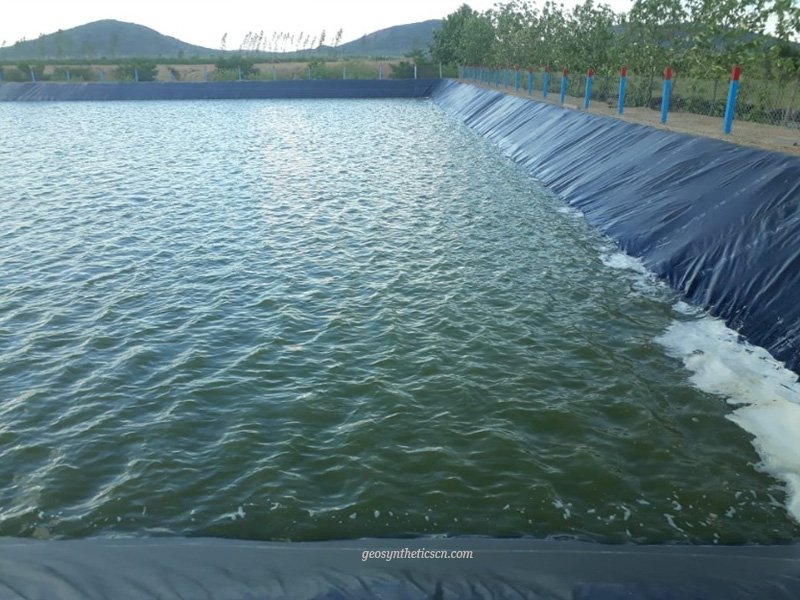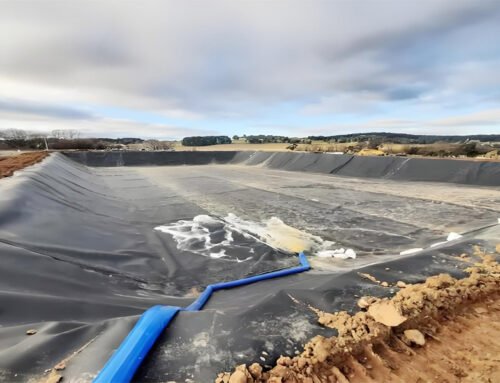Most people will feel hesitate in choosing HDPE Pond Liner or LDPE Pond liner in fish farm project. It is difficult to figure out the benefits and drawbacks of HDPE vs LDPE Pond liner. Generally, HDPE pond liners are chosen for fish farms because of its impermeability, durability, long-term stability, chemical resistance, ease of installation, and suitability for large pond applications. While LDPE is alternative solution for fish farm pond liners in certain situations, especially when flexibility, cost-effectiveness, and conformability are key considerations.
GEOSINCERE is the leading geosynthetics manufacturer and supplier, we wholesale high quality geomembrane pond liner for fish or shrimp farm projects. HDPE vs LDPE Pond Liner, Which One Is Better for Fish Farm? How to buy the right pond liner material for my fish farm project? Let’s compare HDPE vs LDPE pond liner in detail to help you find your right pond liner.
1. What Are The Different Properties of HDPE vs LDPE Pond Liner for Fish Farm?
1.1 Permeability Properties of HDPE vs LDPE Pond Liner
HDPE pond liner has better waterproofing properties while LDPE pond liner generally has higher permeability compared to HDPE pond liner. This means LDPE may allow a higher rate of water seepage, which can result in water loss and the need for frequent replenishment. This is decided by its different density, in which HDPE pond liners have 0.940~0.976g/cm3 density while LDPE is 0.910~0.940g/cm3.
1.2 Durability Properties of HDPE vs LDPE Pond Liner
HDPE pond liner is known for its higher tensile strength and resistance to punctures, providing better protection against potential damage from equipment, wildlife, or other sources. While LDPE pond liner is flexible and conformable, it may not have the same level of durability as HDPE pond liner.
1.3 Long Term Stability of HDPE vs LDPE Pond Liner
HDPE pond liner is often preferred for its long-term stability and resistance to environmental factors, including UV radiation. Prolonged exposure to sunlight can lead to degradation of LDPE pond liner, potentially impacting its performance over time.


1.4 Chemical Resistance
HDPE pond liner generally offers better chemical resistance compared to LDPE pond liner. Fish farms that use water treatment chemicals or other substances may benefit from the enhanced chemical resistance of HDPE pond liner. As we all know that, HDPE pond liner is resistant to many acids, alkalis, and solvents. Here are some chemicals to which HDPE pond liner is generally resistant.
1.4.1 Acids and Alkalis Resistant
The HDPE pond liner can be resistant to Acids including Sulfuric acid (concentrated), Hydrochloric acid (up to 10% concentration) , Nitric acid (up to 20% concentration) Phosphoric acid (up to 85% concentration), and Acetic acid (up to 50% concentration).
The HDPE pond liner can be resistant to Alkalis including Sodium hydroxide (up to 50% concentration) , Potassium hydroxide (up to 50% concentration) , and Ammonium hydroxide (up to 50% concentration).
1.4.2 Solvents
The HDPE pond liner can be resistant to Methanol, Ethanol, Isopropanol (Isopropyl alcohol), Acetone, Toluene, Xylene, or hydrocarbons including Gasoline, Diesel,J et fuel, Lubricating oils, and more.
1.4.3 Oxidizing Agents
The HDPE pond liner can be resistant to Hydrogen peroxide (up to 30% concentration), Sodium hypochlorite (bleach), and water treatment chemicals including Chlorine, Chlorine dioxide, Ozone, etc.
Based on above details, we can understand more clear for HDPE special properties in its function. HDPE pond liner has better chemical resistant than LDPE pond liner.
And the level of resistance can vary depending on factors such as concentration, temperature, and exposure duration. Additionally, specific formulations of HDPE pond liner with enhanced chemical resistance is also available for applications where more stringent requirements in landfill or mining, etc.
1.5 UV Stability
LDPE pond liner is less resistant to UV radiation compared to HDPE pond liner. In fish farm pond applications with significant sunlight exposure, the UV stability of the liner becomes an important factor in preventing degradation.
Here we would like to comparison the two through a table to facilitate you choosing right geomembrane pond liner products for fish farm project.
1.6 Comparison of HDPE vs LDPE Pond Liner Properties
| Properties | HDPE | LDPE |
| Appearance | nontoxic odorless and tasteless | |
| Density | 0.940~0.976g/cm3 | 0.910~0.940g/cm3 |
| Crystallization | 85-65% | 45-65% |
| Softening Point | 125-135℃ | 90-100℃ |
| Break Strength | 27kN/m | 19kN/m |
| Break Elongation | 7 | 5.6 |
| Puncture Resistance | 320N | 175N |
| Environmental Stress Cracking Resistance(ESCR) | General | Higher |
| Dampproof and Waterproof | Better permeability for water, vapor and air, Lower hydroelectricity | worse vapor and water proof |
| Acid, alkali, corrosion and organic solvent resistance | Anti-strong oxidant,acid, alkali and salt. Not dissolve in organic solvents | Anti-acid, alkali and salt |
| Heat and cold-resistance | Good Heat and cold resistance | Brittleness temperature <-70℃ |
| Low temperature brittleness | Good impact resistance, Brittleness temperature < -90℃ |


2 Pond Size and Configuration Considerations
When considering pond liners, the choice between LDPE and HDPE depends on various factors. LDPE, with its flexibility and conformability, may be more suitable for smaller ponds with irregular shapes. Its ability to adapt to contours can be advantageous in such cases.
On the other hand, for larger ponds where impermeability, strength, and durability are of utmost importance, HDPE pond liner is often a better choice. HDPE offers excellent impermeability, ensuring that water does not penetrate the liner. It also exhibits superior strength and durability, allowing it to withstand the demands of larger pond environments.
The decision between LDPE and HDPE ultimately hinges on the specific requirements and characteristics of the pond project. Considerations such as size, shape, and the need for impermeability, strength, and durability will guide the selection process. Consulting with experts in the field can help determine the most appropriate choice for achieving the desired outcomes in pond construction and maintenance.
3 Pond Liner Price Considerations
Quality is important. But a good pond liner price is also the main consideration. Obtaining best pond liner price involves researching and comparing pond liner supplier philippines, requesting multiple quotes, considering material options, negotiating for discounts, and exploring bulk ordering opportunities. It’s crucial to strike a balance between price and quality, ensuring the selected pond liner material meets your specific requirements without compromising on performance and durability. Keep an eye out for seasonal sales and promotions to take advantage of potential discounts. Remember to assess the warranty provided with the pond liner and factor it into your decision. By following these steps, you can find a cost-effective pond liner while maintaining the necessary quality for your project.
4 Installation Considerations
HDPE pond liners are often available in larger panels or rolls, simplifying installation in larger areas. Installing an LDPE pond liner may provide advantages in specific scenarios, but its efficiency might not be as pronounced in large-scale applications.
Geomembrane HDPE liner welding method by automatic and hot wedge welding,is the rule of a hot wedge welding technique. In this method, a heated wedge is used to melt the surfaces of the Pond liner sheets, and the sheets are then pressed together to form a seamless and strong weld joint. In this case HDPE pond liner is generally considered more conducive to heat welding due to its higher melting point of 125-135℃ and better melt flow characteristics than LDPE Liner. The process of hot wedge welding is typically efficient for HDPE liners.
In the perspective of weld strength, HDPE welds are known for their strength and integrity. When properly executed, hot wedge welding creates reliable seams that contribute to the overall impermeability of the liner. While LDPE due to the lower melting point, extra care may be needed to achieve strong and reliable seams.
5 Conclusion
GEOSINCERE is a pond liner company with more than 10 years project experience and provided total solutions for geosynthetics project all over the world.
In this article, we explored liner properties of HDPE vs LDPE Pond Liner, water retention, pond size, environmental conditions, and long-term performance in this article. We hope they are can helpful for you decision-making process, and you can choose HDPE pond liner or LDPE pond liner for certain fish farm pond applications. The LDPE pond liner is especially suitable for smaller or uniquely shaped ponds. The HDPE pond liner is the first choice for large and exposed ponds. It’s essential to carefully evaluate the specific needs of the aquaculture operation.
If any questions or inquiries, please consult with GEOSINCERE geomembrane pond liner experts in pond construction and HDPE liner selection, we can provide valuable insights tailored to the unique requirements of the fish farming operation. Welcome you consult GEOSINCERE team technicians,we will be here for you in 24 hours.





